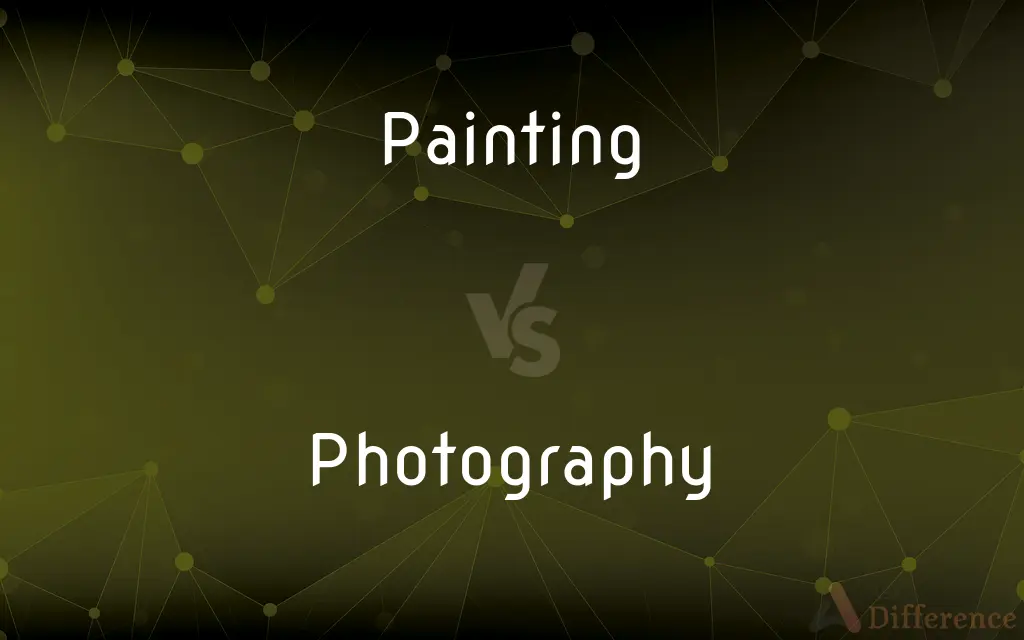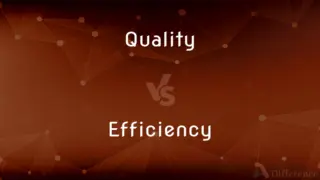Painting vs. Photography — What's the Difference?
By Maham Liaqat & Urooj Arif — Updated on May 2, 2024
Painting involves creating art through brush strokes and pigments, offering subjective expression; photography captures real-life scenes instantaneously, providing objective representation.

Difference Between Painting and Photography
Table of Contents
ADVERTISEMENT
Key Differences
Painting is an artistic process where an artist applies pigments to a surface, using brushes or other tools, to create an image from imagination or inspiration. Whereas, photography involves capturing real images through a camera, focusing on real-life scenes and moments.
Painting allows for a wide range of artistic expression and can depict abstract concepts, unreal scenes, or surreal interpretations. On the other hand, photography typically captures the reality as it appears, although it can be manipulated to some extent through angles and digital editing.
The time taken to create a painting can be extensive, ranging from several hours to months, depending on the complexity and techniques used. Conversely, photography can capture a moment in a fraction of a second, though significant time may also be spent on setting up the shot and post-processing.
Paintings can be highly subjective, with each viewer possibly interpreting the artwork differently based on personal emotions and thoughts. Whereas, photography tends to be more direct and objective, often conveying a clear and specific scene or message.
Painting materials include canvas, oils, acrylics, watercolors, and more, allowing varied textures and effects. In contrast, photography relies on technological tools like cameras, lenses, and software, focusing more on technological skill and less on physical mediums.
ADVERTISEMENT
Comparison Chart
Medium
Pigments, brushes, canvas
Camera, lenses, film/digital sensors
Expression
Subjective, abstract possibilities
Objective, captures reality
Creation Time
Hours to months
Instantaneous capture, with varied editing time
Interpretation
Highly subjective
Generally more objective
Technical Skills
Artistic techniques, color mixing, brush handling
Camera operation, lighting, editing skills
Compare with Definitions
Painting
Often interprets or reimagines reality based on the artist's vision.
Surrealist paintings may depict dream-like scenes that defy logical interpretation.
Photography
Serves both artistic and practical purposes, such as in art, journalism, and documentation.
Documentary photography plays a crucial role in journalism, capturing important moments in real time.
Painting
Can be done using various mediums like oil, acrylic, watercolor.
Watercolor paintings often feature soft, transparent layers and subtle color gradients.
Photography
Art and technique of creating durable images by recording light with a camera.
Photography can capture the fleeting expressions of a person, providing a realistic portrayal.
Painting
Can explore a wide range of subjects from realistic portraits to abstract concepts.
Abstract paintings may use shapes and colors to evoke feelings without depicting real objects.
Photography
Can be digital or film-based, involving various camera types and settings.
Long exposure photography uses a slow shutter speed to blur moving elements like water or clouds.
Painting
Painting is the practice of applying paint, pigment, color or other medium to a solid surface (called the "matrix" or "support"). The medium is commonly applied to the base with a brush, but other implements, such as knives, sponges, and airbrushes, can be used.
Photography
Photography is the art, application, and practice of creating durable images by recording light, either electronically by means of an image sensor, or chemically by means of a light-sensitive material such as photographic film. It is employed in many fields of science, manufacturing (e.g., photolithography), and business, as well as its more direct uses for art, film and video production, recreational purposes, hobby, and mass communication.Typically, a lens is used to focus the light reflected or emitted from objects into a real image on the light-sensitive surface inside a camera during a timed exposure.
Painting
The process, art, or occupation of coating surfaces with paint for a utilitarian or artistic effect.
Photography
The art or practice of taking and processing photographs.
Painting
A picture or design in paint.
Photography
The art or process of producing images of objects on photosensitive surfaces.
Painting
Present participle of paint
Photography
The art, practice, or occupation of taking and printing photographs.
Painting
(countable) An illustration or artwork done with the use of paint.
The Mona Lisa is one of the most famous paintings.
Photography
A body of photographs.
Painting
(uncountable) The action of applying paint to a surface.
The outside of the old house would benefit from some painting.
Photography
The art and technology of producing images on photosensitive surfaces, and its digital counterpart.
Go on a photography course
Painting
(uncountable) The same activity as an art form.
Some artists, like Michelangelo, excel in both painting and sculpture.
Photography
The occupation of taking (and often printing) photographs.
Painting
The act or employment of laying on, or adorning with, paints or colors.
Photography
The science which relates to the action of light on sensitive bodies in the production of pictures, the fixation of images, and the like.
Painting
The work of the painter; also, any work of art in which objects are represented in color on a flat surface; a colored representation of any object or scene; a picture.
Photography
The art or process of producing pictures by this action of light.
Painting
Color laid on; paint.
Photography
The act of taking and printing photographs
Painting
A depicting by words; vivid representation in words.
Photography
The process of producing images of objects on photosensitive surfaces
Painting
Graphic art consisting of an artistic composition made by applying paints to a surface;
A small painting by Picasso
He bought the painting as an investment
His pictures hang in the Louvre
Photography
The occupation of taking and printing photographs or making movies
Painting
Creating a picture with paints;
He studied painting and sculpture for many years
Photography
Often focuses on capturing real-life scenes accurately, but can also be artistically manipulated.
Landscape photography captures nature's beauty, often enhancing colors and contrasts for visual impact.
Painting
The act of applying paint to a surface;
You can finish the job of painting faster with a roller than with a brush
Photography
Relies on technological mastery, including understanding of light, shadows, and composition.
Professional photographers skillfully manipulate light to enhance the mood of their images.
Painting
The occupation of a house painter;
House painting was the only craft he knew
Painting
Art of applying pigments to a surface to create aesthetic images.
Van Gogh used bold brush strokes and vibrant colors to express emotions vividly in his paintings.
Painting
Emphasizes texture and the physicality of the paint.
Impasto techniques create a textured surface where the paint itself adds to the composition.
Common Curiosities
Can photography be considered an art like painting?
Yes, photography is widely recognized as an art form, requiring skill, creativity, and an eye for detail, much like painting.
Which takes longer, creating a painting or taking a photograph?
Generally, painting takes longer due to the manual process, while photography can capture images almost instantaneously.
How do the tools differ between painting and photography?
Painting uses physical tools like brushes and canvas, while photography uses technological tools like cameras and software.
Can both painting and photography manipulate reality?
Yes, both can manipulate reality; painting through subjective interpretation and photography through techniques like lighting, angles, and editing.
How do the costs compare between painting and photography?
Costs can vary widely in both fields depending on materials, tools, and scale of work, with professional equipment being expensive in both arts.
Which is more accessible to beginners?
Photography can be more accessible due to the immediate results and simpler basic techniques, while painting requires learning various artistic skills.
What role does color play in painting compared to photography?
Color in painting involves direct manipulation and mixing by the artist, while in photography, color depends on light capture and post-processing adjustments.
How does the intent of the artist or photographer affect their work?
Intent greatly influences the style, technique, and presentation in both forms, dictating how subjects are interpreted or depicted.
What is the main difference between painting and photography?
Painting is a manual art form focused on subjective expression through pigments, while photography captures real scenes directly with a camera for more objective representation.
Can both painting and photography be digital?
Yes, digital painting and digital photography are both popular modern adaptations of these traditional forms.
Is one medium more expressive than the other?
Painting is often considered more expressive in terms of potential for abstract and surreal interpretations, while photography is praised for its ability to capture and convey real-life intensity.
Which is better for storytelling?
Both can be powerful storytelling mediums; painting can convey deep metaphors and abstract ideas, while photography excels in vivid, realistic portrayals.
What educational paths are available for aspiring painters and photographers?
Both fields offer formal education through art schools and universities, as well as numerous informal workshops and online courses.
What are the professional opportunities in painting and photography?
Professional opportunities vary from independent artist or photographer roles to positions in galleries, studios, media, advertising, and education.
How has technology impacted painting and photography?
Technology has expanded the possibilities in both fields, with digital tools enhancing creative options and accessibility.
Share Your Discovery

Previous Comparison
Quality vs. Efficiency
Next Comparison
Manufacturer vs. FactoryAuthor Spotlight
Written by
Maham LiaqatCo-written by
Urooj ArifUrooj is a skilled content writer at Ask Difference, known for her exceptional ability to simplify complex topics into engaging and informative content. With a passion for research and a flair for clear, concise writing, she consistently delivers articles that resonate with our diverse audience.
















































